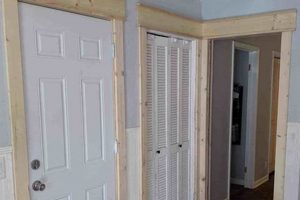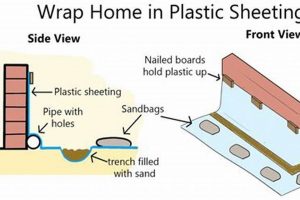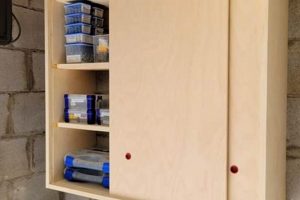A self-constructed pivoting door provides overhead shelter when open. The design hinges horizontally, typically from the top, allowing the panel to swing outward and upward, creating a protective canopy. Applications range from small-scale residential modifications, such as over a garden shed entrance, to larger commercial uses where weather protection is desired at an entryway.
This type of fabrication offers a cost-effective method for enhancing weather protection and increasing the functionality of an opening. Historically, similar pivoting designs have been employed in various architectural contexts to manage sunlight and precipitation. Modern iterations allow individuals to tailor dimensions, materials, and aesthetic features to specific project requirements, fostering customized solutions for weather management. This allows for adaptation to different climates and environments.
The subsequent sections will detail specific considerations related to material selection, structural reinforcement, installation techniques, and safety precautions necessary for the successful fabrication of this type of project. These elements are essential for ensuring durability, safety, and overall project success.
Essential Construction Considerations
This section outlines critical aspects to consider when undertaking a self-assembled pivoting shelter door project, ensuring structural integrity and long-term performance.
Tip 1: Material Selection: Prioritize weather-resistant materials such as treated lumber, aluminum, or composite decking. Untreated wood is susceptible to rot and warping, compromising structural integrity.
Tip 2: Accurate Measurements: Precise measurements of the door frame and opening are crucial. Inaccurate dimensions lead to operational difficulties and potential structural weaknesses. Double-check all measurements before cutting materials.
Tip 3: Hinge Placement and Reinforcement: Hinge selection and placement significantly impact the smooth operation and load-bearing capacity. Employ heavy-duty hinges rated for the door’s weight, and reinforce the mounting points with backing plates to prevent tear-out.
Tip 4: Structural Support: Incorporate internal framing and bracing to prevent sagging or warping of the panel. A robust frame ensures stability, especially for larger openings.
Tip 5: Weather Sealing: Apply weather stripping around the perimeter to minimize water infiltration and drafts when closed. Proper sealing extends the lifespan of the door and improves energy efficiency.
Tip 6: Safety Mechanisms: Integrate a secure latching system to prevent the panel from swinging unexpectedly, particularly in windy conditions. Consider incorporating a safety cable to limit the range of motion and prevent overextension.
Tip 7: Finishing and Protection: Apply a protective coating or paint to safeguard the materials from UV exposure and moisture damage. Regular maintenance, including re-application of the finish, prolongs the lifespan of the structure.
Adhering to these considerations will contribute to the creation of a functional and durable pivoting shelter door. Proper planning and execution are key to a successful project.
The subsequent section explores advanced design modifications and aesthetic enhancements for customized implementations.
1. Material Durability
Material durability is a foundational element in the successful construction of a self-assembled pivoting shelter door. The choice of material directly impacts the structure’s resistance to environmental stressors, including moisture, ultraviolet radiation, and temperature fluctuations. The inherent properties of the selected material dictate the door’s ability to withstand these conditions without significant degradation, warping, or failure. For example, using untreated softwood in a high-humidity environment will predictably lead to rot and structural compromise, rendering the door ineffective and potentially hazardous. Conversely, utilizing treated lumber, aluminum, or composite materials engineered for outdoor applications will significantly extend the lifespan and reliability of the installation.
Consider the scenario of a garden shed equipped with a pivoting shelter door constructed from untreated pine. Over time, exposure to rain and sunlight will cause the pine to swell, crack, and become susceptible to fungal decay. The resulting distortion can impede the door’s ability to close properly, compromising its protective function. In contrast, a door fabricated from pressure-treated lumber, properly sealed and maintained, will retain its structural integrity for a considerably longer period, providing consistent shelter and security. Furthermore, the selection of durable hinges and hardware, resistant to corrosion and wear, complements the overall performance of the door system.
In summary, material durability represents a critical prerequisite for a functional and long-lasting self-assembled pivoting shelter door. Neglecting this factor will inevitably lead to premature failure and necessitate costly repairs or replacements. Prioritizing weather-resistant materials and appropriate protective finishes ensures the extended service life and dependable operation of the shelter door, ultimately maximizing its value and utility.
2. Precise Dimensions
Accurate dimensional measurements are paramount in the context of self-constructed pivoting shelter doors. Deviations from specified dimensions can result in functional impairments, structural instability, and compromised weather resistance, ultimately negating the intended benefits of the structure.
- Frame Integration and Operability
Misaligned dimensions between the door panel and the frame impede smooth operation. Binding, sticking, or incomplete closure can occur if the panel is too large or too small for the opening. This not only makes the door difficult to use but also creates gaps for air and water infiltration, undermining its weatherproofing capabilities. For example, a door panel that is even a quarter of an inch too wide may require forceful closing, potentially damaging the hinges or the frame itself.
- Hinge Alignment and Load Distribution
Incorrect dimensions affect hinge alignment and load distribution. If the door is not perfectly rectangular or square, the hinges will be subjected to uneven stress. This can lead to premature wear, loosening, and eventual failure of the hinge mechanisms. An example is a door panel that is slightly trapezoidal; the hinge on the wider side will bear a disproportionate amount of weight, leading to accelerated degradation.
- Weather Seal Integrity
Precise dimensions are essential for effective weather sealing. If the door panel does not accurately fit the frame, gaps will exist that allow air and water to penetrate. Applying weather stripping to compensate for dimensional inaccuracies is a temporary solution that may not provide a complete or long-lasting seal. A common scenario is a door panel that is too short, leaving a gap at the bottom through which drafts and moisture can enter.
- Structural Stability and Aesthetic Appeal
Deviations from intended dimensions can compromise the overall structural stability and aesthetic appeal of the shelter door. A door that is visibly out of square or disproportionate to the frame appears unprofessional and may indicate underlying structural weaknesses. This can diminish the perceived value and functionality of the project. An example is a door panel that is significantly shorter than the frame height, creating an awkward and unbalanced appearance.
In essence, meticulous attention to dimensional accuracy is crucial for achieving a functional, durable, and aesthetically pleasing self-assembled pivoting shelter door. Accurate measurements translate to smoother operation, enhanced weather resistance, improved structural integrity, and a more professional finished product.
3. Hinge Reinforcement
Hinge reinforcement represents a critical structural consideration within the context of self-constructed pivoting shelter doors. The hinges function as the primary load-bearing components, supporting the weight of the door panel and facilitating its pivotal movement. Inadequate reinforcement at the hinge attachment points leads directly to premature failure, rendering the door inoperable and potentially unsafe. The connection between the hinges and the door frame and panel must withstand repeated stress from opening and closing, wind loading, and the weight of the door itself. Failure to properly reinforce these points results in hinge detachment, wood splitting, and ultimately, structural compromise.
Effective hinge reinforcement techniques include the use of backing plates, often fabricated from steel or similar durable material, which distribute the load over a larger surface area. These plates are typically installed behind the door frame and door panel at the hinge attachment locations, providing a solid anchor point for the screws or bolts. Furthermore, utilizing longer, heavier-gauge screws or bolts, in conjunction with appropriate pilot holes to prevent wood splitting, enhances the connection strength. The choice of hinge type also plays a crucial role; heavy-duty hinges designed for outdoor applications are essential for withstanding the rigors of weather exposure and frequent use. Consider a scenario where a large, heavy wooden awning door is installed without proper hinge reinforcement. The repeated stress of opening and closing, combined with wind forces, will eventually cause the screws to pull out of the wood, leading to sagging and eventual detachment of the door. Conversely, a similar door with reinforced hinges, utilizing backing plates and robust fasteners, will maintain its structural integrity over an extended period, providing reliable shelter and security.
In conclusion, hinge reinforcement is not merely an optional upgrade but a fundamental requirement for the successful construction and long-term performance of a self-assembled pivoting shelter door. Proper reinforcement techniques mitigate the risk of hinge failure, ensuring the door remains functional, safe, and aesthetically pleasing for years to come. Neglecting this aspect undermines the overall integrity of the structure and can lead to costly repairs or complete replacement. The investment in robust hinge reinforcement is, therefore, a prudent measure that safeguards the longevity and utility of the entire shelter door system.
4. Structural Integrity
Structural integrity is paramount in the context of a self-constructed pivoting shelter door. The inherent design, characterized by a large panel swinging outward and upward, places considerable stress on the supporting framework. A lack of sufficient structural integrity leads to premature failure, manifested as warping, sagging, or complete collapse of the door. The causes of structural failure range from inadequate material selection to improper construction techniques, all directly impacting the door’s ability to withstand environmental forces and its own weight. An example illustrating this cause-and-effect relationship is a door built with insufficient internal bracing. Under wind load, the unsupported panel bows outward, placing undue stress on the hinges and frame, leading to eventual deformation and functional impairment.
The importance of structural integrity extends beyond mere functionality; it directly impacts safety. A compromised structure poses a risk of sudden collapse, potentially causing injury. Real-world applications demonstrate the practical significance of this understanding. Consider the scenario of a farm shed utilizing a self-built awning door for equipment storage. If the door lacks sufficient structural support, a heavy snowfall could overload the panel, causing it to buckle and potentially detach, posing a hazard to individuals accessing the shed. Conversely, a properly engineered door, incorporating robust framing and high-quality materials, will withstand such loads, ensuring continued functionality and safety. Further, it saves money in the long term.
In conclusion, structural integrity is an indispensable component of a self-assembled pivoting shelter door. Ensuring adequate strength and stability requires careful consideration of material selection, construction techniques, and environmental factors. While the “do-it-yourself” nature of the project offers cost savings and customization opportunities, it also necessitates a thorough understanding of structural principles. Challenges include accurately assessing load requirements and implementing effective reinforcement strategies. The long-term success of the project hinges on prioritizing structural integrity, ensuring a safe, functional, and durable shelter solution.
5. Weather Sealing
Weather sealing constitutes a critical performance parameter for self-constructed pivoting shelter doors. The effectiveness of the weather sealing directly influences the interior environmental conditions, the longevity of the door structure, and overall energy efficiency. Compromised sealing leads to undesirable outcomes ranging from increased energy consumption to accelerated material degradation.
- Air Infiltration Reduction
Effective weather sealing minimizes air infiltration, preventing drafts and maintaining a consistent interior temperature. Gaps around the perimeter of the door panel serve as pathways for unwanted air exchange. This infiltration increases heating and cooling costs, as the HVAC system must compensate for the temperature fluctuations. For instance, a poorly sealed awning door in a workshop can result in discomfort for occupants during cold weather due to noticeable drafts.
- Water Intrusion Prevention
Robust weather sealing prevents water intrusion, protecting the interior space and the door structure from water damage. Rainwater can penetrate gaps and seams, leading to mold growth, wood rot, and corrosion of metal components. A common scenario involves rainwater seeping under the bottom edge of an improperly sealed awning door, causing damage to the flooring and potentially compromising the structural integrity of the door frame.
- Insect and Pest Deterrence
Proper weather sealing deters insects and pests from entering the structure through gaps around the door. Insects and rodents can exploit even small openings to gain access to the interior, creating unsanitary conditions and potentially damaging stored goods. For example, a garden shed with an awning door that lacks adequate sealing may become infested with insects, damaging gardening tools and supplies.
- Material Longevity Enhancement
Effective weather sealing enhances the longevity of the door structure by protecting it from the elements. By preventing moisture and UV radiation from directly impacting the door panel and frame, weather sealing minimizes the risk of warping, cracking, and fading. A well-sealed awning door constructed from wood, for example, will resist rot and decay, extending its service life significantly compared to an unsealed or poorly sealed counterpart.
In summary, the implementation of effective weather sealing strategies is essential for maximizing the performance and durability of a self-constructed pivoting shelter door. By mitigating air infiltration, preventing water intrusion, deterring pests, and protecting the structural materials, proper sealing contributes to a more comfortable, energy-efficient, and long-lasting shelter solution.
6. Secure Latching
Secure latching mechanisms are critical for self-constructed pivoting shelter doors. The design inherently exposes the structure to external forces, necessitating robust latching to ensure safety, security, and weather resistance. Inadequate latching compromises these essential functions.
- Wind Resistance and Safety
A secure latch prevents the awning door from unexpectedly swinging open due to wind gusts. Uncontrolled movement poses a safety hazard, particularly in high-traffic areas or during severe weather conditions. A robust latching system mitigates this risk. An example includes a spring-loaded bolt mechanism that automatically engages upon closure, preventing wind-induced opening.
- Security Against Intrusion
A reliable latching mechanism provides a level of security against unauthorized entry. While not intended as a primary security barrier in all applications, a properly secured latch deters casual intrusion and protects stored contents. Consider a storage shed using an awning door; a strong latch prevents opportunistic theft of tools or equipment. Padlock compatibility is an addition to security.
- Weather Sealing Effectiveness
Secure latching contributes to the overall effectiveness of weather sealing. A tight, secure closure ensures that the door panel presses firmly against weather stripping, minimizing air and water infiltration. A loose or ineffective latch allows gaps to form, compromising the seal. Cam-over latches excel at drawing the door tightly closed, improving the effectiveness of installed weather seals.
- Structural Stability and Longevity
A secure latching system contributes to the structural stability of the awning door when closed. The latch helps distribute the load evenly across the frame, reducing stress on the hinges and preventing warping or sagging over time. Latches that pull the door firmly against the frame improve overall rigidity.
The interplay of these facets demonstrates the importance of selecting and implementing a robust latching system. The selection process requires consideration of environmental conditions, security requirements, and the overall construction of the door. Failure to prioritize secure latching undermines the functionality and safety of the self-constructed pivoting shelter door, creating vulnerabilities that can compromise its intended purpose.
7. Protective Finishing
Protective finishing plays a crucial role in the longevity and performance of self-constructed pivoting shelter doors. Exposure to environmental elements necessitates a protective layer to mitigate degradation and maintain structural integrity. Selection and application of appropriate finishes represent a significant aspect of the construction process.
- UV Radiation Mitigation
Ultraviolet (UV) radiation from sunlight degrades many common building materials, leading to fading, cracking, and reduced structural strength. Protective finishes, such as paints and sealants containing UV inhibitors, shield the underlying material from this damage. An example includes applying a marine-grade varnish to a wooden awning door, which protects the wood from UV-induced degradation and maintains its appearance over time. The absence of UV protection results in premature aging and necessitates more frequent maintenance or replacement.
- Moisture Barrier Formation
Moisture penetration leads to rot in wooden structures and corrosion in metallic components. Protective finishes create a barrier that prevents moisture from reaching the underlying material, extending its lifespan and preventing structural damage. Applying a waterproof sealant to all surfaces of an awning door, particularly joints and seams, prevents water infiltration and protects against moisture-related deterioration. Failure to create a moisture barrier can lead to significant structural problems and costly repairs.
- Insect and Pest Resistance
Certain protective finishes incorporate insecticides or create a barrier that deters insects and pests from infesting the wood. This is particularly important for wooden awning doors, as insect infestations can compromise the structural integrity of the wood. Applying a borate-based wood preservative provides long-term protection against termites and other wood-boring insects, preventing costly damage and maintaining the door’s structural soundness. Lack of insect resistance can result in severe structural damage requiring extensive repairs or replacement.
- Aesthetic Enhancement and Value Preservation
Protective finishes enhance the aesthetic appeal of the awning door and preserve its value over time. A well-applied finish improves the overall appearance of the structure, adding to its visual appeal and increasing its perceived value. Applying a high-quality paint or stain not only protects the door from the elements but also enhances its aesthetic appeal, making it a more attractive and valuable addition to the property. Disregarding aesthetic enhancement can lead to diminished curb appeal and reduced property value.
The multifaceted benefits of protective finishing underscore its importance in the successful construction and long-term performance of self-constructed pivoting shelter doors. Proper selection and application of appropriate finishes protect the door from environmental damage, deter pests, enhance its aesthetic appeal, and preserve its value over time. These measures contribute to the overall durability, functionality, and aesthetic appeal of the structure, maximizing its utility and ensuring its longevity.
Frequently Asked Questions
This section addresses common inquiries regarding the design, construction, and maintenance of self-assembled pivoting shelter doors, providing clarity on key aspects of these projects.
Question 1: What materials are most suitable for constructing a pivoting shelter door?
Durable, weather-resistant materials such as pressure-treated lumber, aluminum, or composite decking are recommended. Untreated wood is prone to rot and warping. Metal requires rust preventative finishing. Material suitability directly impacts longevity and structural integrity.
Question 2: How does one ensure proper weather sealing for a self-built pivoting door?
Employ weather stripping around the perimeter of the door and frame to minimize air and water infiltration. Overlapping designs and tight closures will maximize weather resilience.
Question 3: What type of hinges are recommended for a pivoting shelter door, and how should they be installed?
Heavy-duty hinges designed for outdoor use are essential. Reinforce the hinge mounting points with backing plates to distribute the load and prevent tear-out. Adequate hinge installation prevents sagging and detachment.
Question 4: How can the structural integrity of a large pivoting shelter door be enhanced?
Incorporate internal framing and bracing to prevent warping or sagging. Reinforce corners and joints with metal connectors. These elements significantly contribute to the door’s stability under wind and weight loads.
Question 5: What safety precautions are necessary when installing a pivoting shelter door?
Implement a secure latching system to prevent uncontrolled swinging. Use safety cables to limit the door’s range of motion and prevent overextension. Handle heavy materials with appropriate lifting equipment and assistance.
Question 6: How does one maintain a self-constructed pivoting shelter door to ensure its longevity?
Regularly inspect the door for signs of wear, damage, or corrosion. Reapply protective finishes as needed. Lubricate hinges and latches to ensure smooth operation. Promptly address any structural issues to prevent further deterioration.
These answers provide fundamental guidance for individuals undertaking self-assembled pivoting shelter door projects. Attention to detail and adherence to sound construction practices are crucial for achieving a safe, functional, and durable outcome.
The subsequent section explores design modifications and aesthetic considerations for customized pivoting shelter door implementations.
Concluding Remarks
This exposition has detailed the essential considerations for constructing a functional and durable diy awning door. Emphasis has been placed on material selection, structural reinforcement, weather sealing, and safety mechanisms. Proper execution of these elements directly contributes to the longevity and utility of this type of structure.
The successful implementation of a self-constructed pivoting shelter door demands a thorough understanding of engineering principles and a commitment to diligent construction practices. While the information presented provides a comprehensive foundation, responsible builders should supplement this knowledge with applicable building codes and safety regulations to ensure a safe and enduring result.







